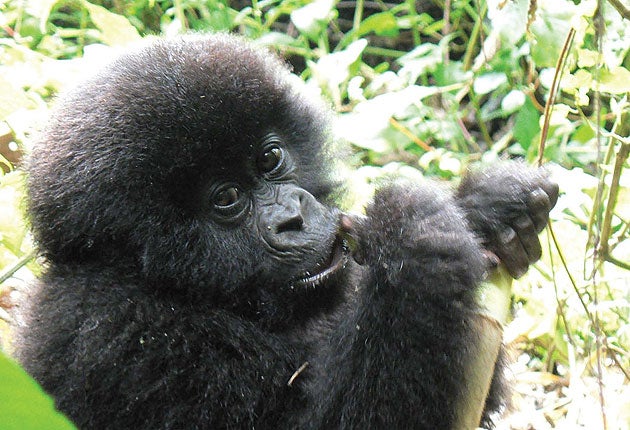Miza's rescue brings hope to mountain gorillas

Your support helps us to tell the story
From reproductive rights to climate change to Big Tech, The Independent is on the ground when the story is developing. Whether it's investigating the financials of Elon Musk's pro-Trump PAC or producing our latest documentary, 'The A Word', which shines a light on the American women fighting for reproductive rights, we know how important it is to parse out the facts from the messaging.
At such a critical moment in US history, we need reporters on the ground. Your donation allows us to keep sending journalists to speak to both sides of the story.
The Independent is trusted by Americans across the entire political spectrum. And unlike many other quality news outlets, we choose not to lock Americans out of our reporting and analysis with paywalls. We believe quality journalism should be available to everyone, paid for by those who can afford it.
Your support makes all the difference.Miza should be dead. The baby gorilla had been hanging off her mother's back when gunmen slaughtered 10 endangered mountain gorillas in Congo's Virunga National Park last year. Miza's mother was one of those killed. Rangers couldn't find baby Miza and assumed the worst.
Several days passed. Then Miza's father, an old silverback called Kabirizi, found her wandering alone in the jungle. He brought her home, where she is now being raised by her older sister.
Miza's story caught the attention of Craig Hatkoff, an American author who writes children's books about animals. Hatkoff, together with his two daughters, nine-year-old Isballa and Juliana, 13, decided to write a book about Miza.
Now he hopes the book, "Looking for Miza: The True Story of the Mountain Gorilla Family Who Rescued One of Their Own", will help draw attention to the plight of Congo's 380 mountain gorillas - and the people who dodge bullets to protect them.
The Democratic Republic of Congo, one of Africa's largest countries, stretches from the Atlantic to the Great Lakes of East Africa. For more than a decade it has been ravaged by war. Peace deals have been signed but in the country's eastern regions, the conflict has never stopped.
Hatkoff's book, aimed squarely at young children, treads carefully when recounting Congo's chaos. He doesn't mention the slaughter of the gorillas, describing instead how "one day, when Miza and her mother were out searching for food, Miza's mother disappeared, leaving her baby alone and frightened."
Hatkoof insists though that by creating a connection with gorillas like Miza it can help draw attention to the Congo's broader problems.
"This is no longer just about saving the gorillas," he told Reuters. "We have to save the people there too who need clean water, food security, education and health care. These are complicated problems but they are solveable."
The book forms the centrepiece of a new campaign aimed at raising awareness of the crisis in Africa's Great Lakes region. It will be launched tomorrow at the Kids Gorilla Summit in New York.
One of the groups backing the campaign, the conservation organisation Wildlife Direct, employs a team of rangers in Virunga National Park that aim to protect the gorillas. There are believed to be just 720 mountain gorillas left in the world - more than half can be found in eastern Congo.
The Wildlife Direct rangers regularly blog about their struggles protecting the endangered gorillas in a region rife with rebel groups. In recent weeks fighting in Congo's North Kivu region has escalated. Some of the fighting, between Congolese government forces and troops belonging to the rebel leader, General Laurent Nkunda, is taking place on the slopes of the Mikeno volcano, which is home to many of the park's gorillas.
One of the park's rangers, Pierre Peron, described in a posting on Wednesday, how the sound of heavy artillery and machine gun fire had woken him early in the morning. The fighting continued all day.
Pierre and two other rangers left their post to return to Goma, the capital of North Kivu, a two hour drive away.
"On the way, we saw the tanks parked on the side of the road," Pierre wrote, "from where they were firing up the slopes of the hill towards the rebel positions. On the road there were also a lot of weary soldiers who were taking a break from fighting on the front."
Join our commenting forum
Join thought-provoking conversations, follow other Independent readers and see their replies
Comments